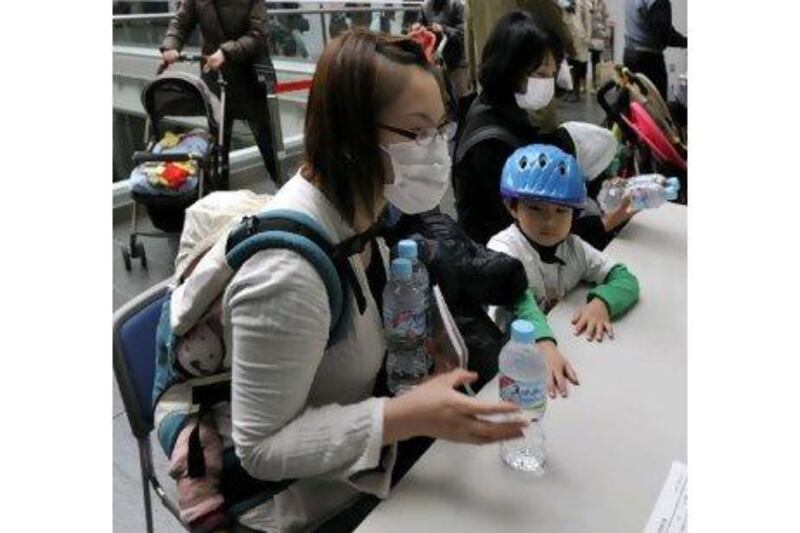Two workers at the Fukushima nuclear plant, damaged in this month's Japanese earthquake, were hospitalised yesterday after being exposed to high levels of radiation when they came into contact with contaminated water.
The two were laying cables in the basement of a turbine building as part of efforts to restore power to the No 3 reactor when radioactive water they had stepped in seeped into their clothing and burnt their feet, Japan's Kyodo news agency reported.
The workers were exposed to between 173 and 180 millisieverts of radiation, below the annual limit of 250 millisieverts set for workers trying to stabilise the stricken plant. "They found themselves in a puddle of water.
Although they wore protective clothing, the contaminated water seeped in and their legs were exposed to radiation," said a spokesman for the Nuclear and Industrial Safety Agency, Japan's nuclear watchdog, according to Agence France-Presse.
A third employee working with them was exposed to similar levels of radiation, but was not hospitalised. All three were men in their 20s or 30s.
The Japanese government's chief spokesman, Yukio Edano, said that workers were not being put unduly at risk, saying the water exposure was "unforeseen", and insisting the maximum limit for workers was safe.
The authorities increased to 250 millisieverts the maximum annual radiation dose employees could be exposed to so staff could continue working to stabilise the plant despite the high radiation levels. According to the World Nuclear Association, in most countries workers should receive no more than 20 millisieverts per year, averaged over five years, with a 50 millisieverts maximum in any one year.
"The decision to increase permissible radiation exposure was taken on the advice of experts, who say that workers are able to withstand up to 250 millisieverts per year before radiation has an effect on their health," he said.
However, studies of populations after cases of nuclear fallout have indicated that those receiving above 50 millisieverts are more at risk of developing cancer. In the US, average exposure is about six millisieverts per year.
So far, 14 workers at the Fukushima plant have been exposed to more than 100 millisieverts since the crisis began on March 11, according to the facility's operator, the Tokyo Electric Power Company.
Levels of radiation remain high even in areas outside the 20-kilometre evacuation zone around the plant, and the 20 to 30km zone in which people are advised to remain indoors and keep windows shut.
Data posted online yesterday by the Fukushima prefecture showed radiation levels in Fukushima City, 61km north-west of the nuclear facility, were 4.68 microsieverts per hour, or around 100 times more than normal. In other locations about 40km from the plant, levels were between about 15 and 40 times the normal background radiation.
Meanwhile, Tokyo has been hit by panic buying of water after authorities said on Wednesday that radioactive iodine was detected in water supplies at double the safe level for children under 12 months.
Among those stocking up was Reiko Matsumoto, who has a five-year-old child.
"The first thought was that I need to buy bottles of water," Mr Matsumoto, an estate agent, told the Associated Press. "I also don't know whether I can let her take a bath."
Many shops ran out of water, and disruptions to deliveries caused supermarkets to limit the amount of milk, toilet paper, rice and water they would sell.
Authorities distributed 240,000 small bottles of water, or three for each of the 80,000 babies in the city under 12 months.
Concentrations of radioactive iodine in water in Tokyo declined to safe levels yesterday, but they increased in other areas.
Higher than normal levels of radioactivity have also been detected in milk and vegetables from areas near the plant, as well as in seawater.
Australia yesterday followed the US and said it was banning the import of vegetables and dairy produce from districts around the Fukushima facility. Canada said it would impose stricter controls on Japanese food imports. Hong Kong now requires Japan to carry out tests on seafood, meat and egg exports.
Work continued yesterday to restore power to cooling functions at the plant after these were knocked out by the tsunami that followed the March 11 earthquake. Temperatures in reactors and pools of spent fuel increased, leading to radiation releases.
External power supplies have been reconnected to all six reactors, although checks on equipment are having to be carried out before engineers can switch on power to all of them.
The death toll from the earthquake and tsunami stood at 9,811 yesterday, with 17,541 listed as missing.
Reports have indicated that food and medical supplies at some evacuation centres are much improved. Restaurants have given food, consignments of donated clothes have arrived and power and water supplies have in many cases been reconnected. Post office vans have travelled to affected areas to enable residents to withdraw money from accounts.
However, 660,000 households in Japan's north-east remain without water, and 209,000 still lack electricity.






